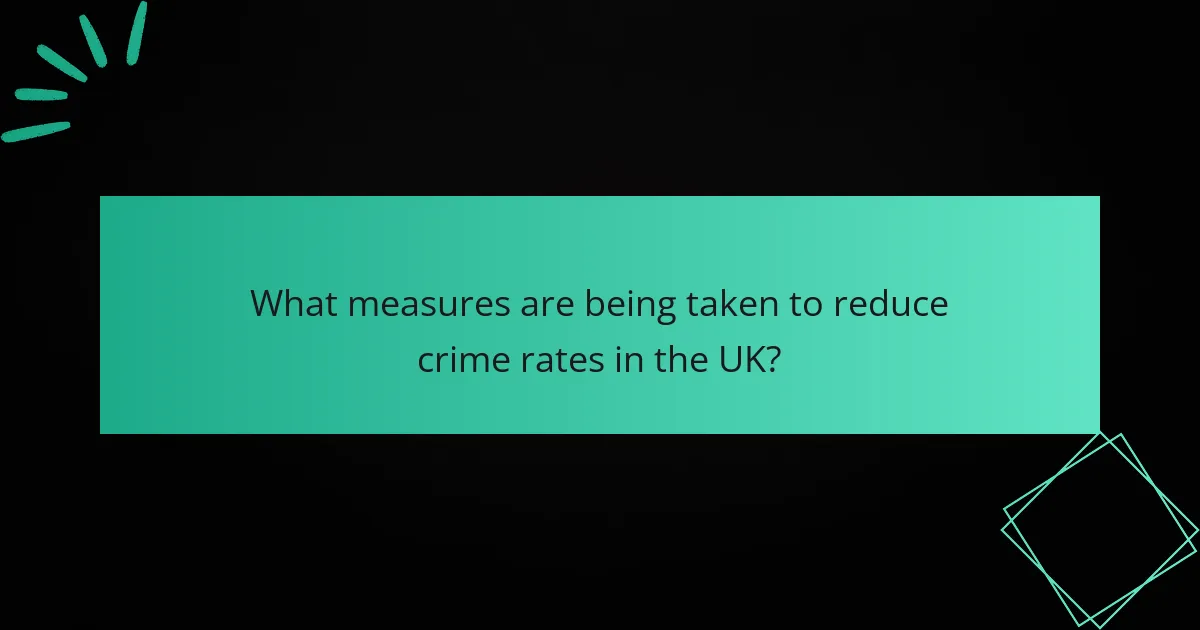Crime rates across major UK cities exhibit considerable variation, shaped by diverse factors including population density, socioeconomic conditions, and local policing strategies. Cultural influences also play a significant role, affecting the prevalence and types of crime, which range from theft and burglary to violent offenses. By examining these dynamics, residents and visitors can better navigate safety concerns and understand the underlying issues contributing to crime in different regions.

How do crime rates compare across major UK cities?
Crime rates in major UK cities vary significantly, influenced by factors such as population density, socioeconomic conditions, and local policing strategies. Understanding these differences can help residents and visitors navigate safety concerns more effectively.
London crime rate statistics
London, being the capital, has a diverse crime landscape. The overall crime rate tends to be higher than the national average, with property crimes like burglary and theft being particularly prevalent. Recent estimates suggest that crime rates in London can fluctuate, often falling within the range of 80 to 100 crimes per 1,000 residents annually.
Areas such as Westminster and Camden report some of the highest crime figures, while outer boroughs like Richmond and Sutton generally experience lower rates. Residents should stay informed about local trends and utilize community resources for safety tips.
Birmingham crime rate statistics
Birmingham’s crime rate is also notable, with figures typically ranging between 70 and 90 crimes per 1,000 residents. Violent crime and anti-social behavior are common concerns, particularly in urban centers. However, many neighborhoods have seen improvements due to community initiatives and increased police presence.
Specific areas like Aston and Handsworth have historically reported higher crime rates, while suburbs such as Sutton Coldfield tend to be safer. Engaging with local community watch programs can enhance personal safety and awareness.
Manchester crime rate statistics
Manchester’s crime rate is comparable to Birmingham’s, often reported between 80 and 100 crimes per 1,000 residents. The city has faced challenges with gang-related violence and drug offenses, but ongoing efforts by law enforcement aim to address these issues effectively.
Neighborhoods like Moss Side and Hulme have been identified as higher-risk areas, while places like Didsbury and Chorlton are generally safer. Residents are encouraged to stay vigilant and participate in local safety initiatives to foster a secure environment.

What are the cultural factors influencing crime rates in the UK?
Cultural factors significantly influence crime rates in the UK, shaping both the prevalence and types of crime. Elements such as socioeconomic status, community engagement, and social norms play crucial roles in determining crime dynamics across different regions.
Socioeconomic status impact
Community engagement effects
Community engagement plays a vital role in mitigating crime rates in the UK. Strong social ties and active participation in community activities can foster a sense of belonging and responsibility, which discourages criminal behavior. Neighborhood watch programs and local events can enhance vigilance and cooperation among residents.

What are the most common types of crime in the UK?
The most common types of crime in the UK include theft, burglary, and violent offenses. Understanding these categories helps in grasping the overall crime landscape and addressing safety concerns effectively.
Violent crime prevalence
Violent crime in the UK encompasses offenses such as assault, robbery, and homicide. While overall rates can fluctuate, violent crime typically represents a significant portion of reported incidents, often constituting around 15-20% of total crime figures.
Factors influencing violent crime rates include socioeconomic conditions, substance abuse, and gang activity. Urban areas tend to experience higher rates compared to rural regions, making location a critical aspect of understanding these statistics.
Property crime statistics
Property crimes, including burglary, vehicle theft, and vandalism, are among the most frequently reported offenses in the UK. These crimes often account for over half of all recorded criminal activity, with burglary being particularly prevalent in residential areas.
To mitigate property crime risks, homeowners are encouraged to invest in security measures, such as alarm systems and neighborhood watch programs. Awareness of local crime trends can also aid in taking proactive steps to enhance personal and community safety.

How do crime rates in the UK compare to other European countries?
Crime rates in the UK are generally higher than in many other European countries, particularly in violent crime categories. However, property crime rates can vary significantly, with some countries experiencing lower theft and burglary rates compared to the UK.
UK vs. Germany crime rates
The UK has a higher overall crime rate than Germany, especially in violent crimes. For instance, Germany benefits from stricter gun control laws, which contribute to lower homicide rates compared to the UK.
In terms of property crime, both countries experience similar rates, but Germany often reports lower instances of burglary. This difference can be attributed to various factors, including urban planning and community policing strategies.
UK vs. France crime rates
When comparing the UK to France, the UK typically has higher rates of violent crime, including assaults and homicides. France, however, has seen an increase in certain types of crime, particularly in urban areas, which complicates direct comparisons.
Property crime rates in France are generally lower than in the UK, with fewer reported burglaries and thefts. This may be influenced by cultural attitudes towards crime prevention and community safety initiatives in France.

What measures are being taken to reduce crime rates in the UK?
The UK is implementing various strategies to reduce crime rates, focusing on policing, community engagement, and prevention programs. These measures aim to address the root causes of crime and enhance public safety across different regions.
Police initiatives in London
In London, police initiatives include increased patrols in high-crime areas and the use of technology such as CCTV and data analytics to predict and prevent crime. The Metropolitan Police also collaborates with local communities to build trust and encourage reporting of criminal activities.
Programs like Operation Trident focus on tackling gun crime and gang-related violence, while initiatives such as the Safer Neighbourhoods Teams empower local officers to engage with residents and address specific concerns. These efforts aim to create a safer environment and reduce overall crime rates.
Community programs in Birmingham
Birmingham has launched several community programs aimed at reducing crime through engagement and support. Initiatives like the Birmingham Crime Reduction Partnership bring together local authorities, businesses, and community groups to address crime collaboratively.
Programs such as youth outreach and mentorship schemes target at-risk individuals, providing them with alternatives to crime. Additionally, community safety workshops educate residents on crime prevention techniques, fostering a proactive approach to safety and security in neighborhoods.

How does public perception of crime differ across cultures?
Public perception of crime varies significantly across cultures, influenced by factors such as historical context, social norms, and media portrayal. In some societies, crime is viewed as a pervasive threat, while in others, it may be seen as an isolated issue.
Public fear of crime in urban areas
In urban areas, public fear of crime can be heightened due to higher population density and visibility of criminal activity. Residents may feel more vulnerable, leading to increased anxiety about personal safety and property security. This fear can manifest in various ways, such as avoidance of certain neighborhoods or increased demand for security measures.
Comparatively, cities with lower crime rates often experience less public fear, even if crime does occur. For example, a city with a crime rate in the low single digits per 1,000 residents may foster a sense of safety, while another with rates in the double digits can create a pervasive atmosphere of concern.
Media influence on crime perception
The media plays a crucial role in shaping public perception of crime, often amplifying fears through sensational reporting. Coverage of violent crimes, especially those involving vulnerable populations, can lead to a distorted view of safety, making crime seem more prevalent than it is. This phenomenon is known as “mean world syndrome,” where heavy media consumers perceive the world as more dangerous.
Moreover, the type of media consumed can vary by culture, affecting perceptions differently. For instance, in countries where crime dramas are popular, viewers may develop heightened fears based on fictional portrayals. Understanding the influence of media can help individuals critically assess their perceptions and differentiate between reality and sensationalism.

What role does legislation play in shaping crime rates?
Legislation significantly influences crime rates by establishing legal frameworks that dictate acceptable behavior and consequences for violations. Effective laws can deter criminal activity, while poorly designed or enforced laws may fail to address underlying issues, potentially leading to increased crime.
Impact of gun control laws
Gun control laws can directly affect crime rates by regulating access to firearms. Stricter regulations often correlate with lower rates of gun-related violence, as they limit the availability of weapons to potential offenders. For instance, countries with comprehensive gun control measures, like Japan, typically experience significantly lower homicide rates compared to those with more lenient laws, such as the United States.
However, the effectiveness of gun control can vary based on cultural attitudes towards firearms and enforcement practices. For example, in regions where gun ownership is deeply ingrained in the culture, even strict laws may face challenges in implementation, leading to mixed outcomes in crime reduction.
Effects of drug policy reforms
Drug policy reforms can reshape crime rates by altering the legal status of certain substances and shifting focus from criminalization to public health. Countries that have decriminalized or legalized drugs, like Portugal, have seen reductions in drug-related crime and improvements in public health outcomes, such as lower overdose rates.
It’s essential to consider the broader implications of drug policy reforms. While reducing penalties for drug possession can decrease incarceration rates, it may also require robust support systems for addiction treatment and prevention to ensure that crime rates do not rebound due to increased substance use.



